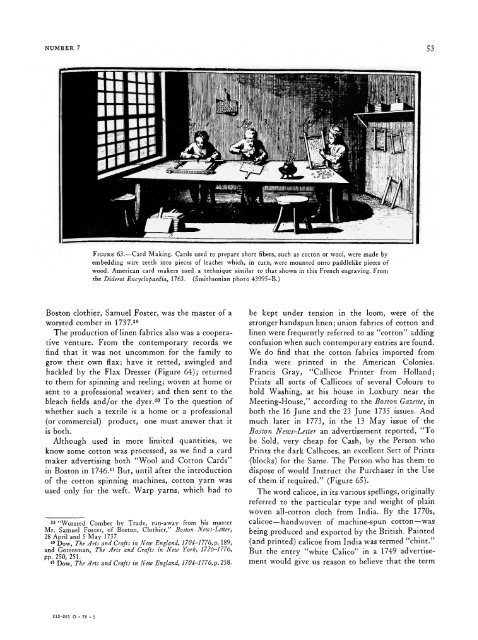The Copp Family Textiles - Smithsonian Institution Libraries
The Copp Family Textiles - Smithsonian Institution Libraries
The Copp Family Textiles - Smithsonian Institution Libraries
Create successful ePaper yourself
Turn your PDF publications into a flip-book with our unique Google optimized e-Paper software.
NUMBER 7 53<br />
FIGURE 63.—Card Making. Cards used to prepare short fibers, such as cotton or wool, were made by<br />
embedding wire teeth into pieces of leather which, in turn, were mounted onto paddlelike pieces of<br />
wood. American card makers used a technique similar to that shown in this French engraving. From<br />
the Diderot Encyclopaedia, 1763. (<strong>Smithsonian</strong> photo 43995-B.)<br />
Boston clothier, Samuel Foster, was the master of a<br />
worsted comber in 1737. 39<br />
<strong>The</strong> production of linen fabrics also was a cooperative<br />
venture. From the contemporary records we<br />
find that it was not uncommon for the family to<br />
grow their own flax; have it retted, swingled and<br />
hackled by the Flax Dresser (Figure 64); returned<br />
to them for spinning and reeling; woven at home or<br />
sent to a professional weaver; and then sent to the<br />
bleach fields and/or the dyer. 40 To the question of<br />
whether such a textile is a home or a professional<br />
(or commercial) product, one must answer that it<br />
is both.<br />
Although used in more limited quantities, we<br />
know some cotton was processed, as we find a card<br />
maker advertising both "Wool and Cotton Cards"<br />
in Boston in 1746. 41 But, until after the introduction<br />
of the cotton spinning machines, cotton yarn was<br />
used only for the weft. Warp yarns, which had to<br />
39 "Worsted Comber by Trade, run-away from his master<br />
Mr. Samuel Foster, of Boston, Clothier," Boston News-Letter,<br />
28 April and 5 May 1737.<br />
40 Dow, <strong>The</strong> Arts and Crafts in New England, 1704-1776,p. 189,<br />
and Gottesman, <strong>The</strong> Arts and Crafts in New York, 1726-1776,<br />
pp. 250, 251.<br />
« Dow, <strong>The</strong> Arts and Crafts in New England, 1704-1776,p. 258.<br />
213-261 O - 76 - 5<br />
be kept under tension in the loom, were of the<br />
stronger handspun linen; union fabrics of cotton and<br />
linen were frequently referred to as "cotton" adding<br />
confusion when such contemporary entries are found.<br />
We do find that the cotton fabrics imported from<br />
India were printed in the American Colonies.<br />
Francis Gray, "Callicoe Printer from Holland;<br />
Prints all sorts of Callicoes of several Colours to<br />
hold Washing, at his house in Loxbury near the<br />
Meeting-House," according to the Boston Gazette, in<br />
both the 16 June and the 23 June 1735 issues. And<br />
much later in 1773, in the 13 May issue of the<br />
Boston News-Letter an advertisement reported, "To<br />
be Sold, very cheap for Cash, by the Person who<br />
Prints the dark Callicoes, an excellent Sett of Prints<br />
(blocks) for the Same. <strong>The</strong> Person who has them to<br />
dispose of would Instruct the Purchaser in the Use<br />
of them if required." (Figure 65).<br />
<strong>The</strong> word calicoe, in its various spellings, originally<br />
referred to the particular type and weight of plain<br />
woven all-cotton cloth from India. By the 1770s,<br />
calicoe—handwoven of machine-spun cotton—was<br />
being produced and exported by the British. Painted<br />
(and printed) calicoe from India was termed "chint."<br />
But the entry "white Calico" in a 1749 advertisement<br />
would give us reason to believe that the term

















